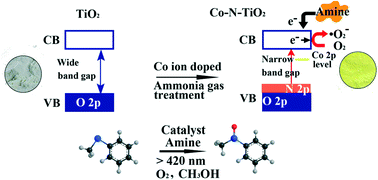当前位置:
X-MOL 学术
›
Catal. Sci. Technol.
›
论文详情
Our official English website, www.x-mol.net, welcomes your
feedback! (Note: you will need to create a separate account there.)
Amine coupled ordered mesoporous (Co–N) co-doped TiO2: a green photocatalyst for the selective aerobic oxidation of thioether
Catalysis Science & Technology ( IF 4.4 ) Pub Date : 2017-08-14 00:00:00 , DOI: 10.1039/c7cy00946a Mingming Zou 1, 2, 3, 4 , Lu Feng 1, 2, 3, 4 , Tiju Thomas 5, 6, 7, 8 , Minghui Yang 1, 2, 3, 4, 9
Catalysis Science & Technology ( IF 4.4 ) Pub Date : 2017-08-14 00:00:00 , DOI: 10.1039/c7cy00946a Mingming Zou 1, 2, 3, 4 , Lu Feng 1, 2, 3, 4 , Tiju Thomas 5, 6, 7, 8 , Minghui Yang 1, 2, 3, 4, 9
Affiliation

|
Usually oxygen cannot participate in the selective oxidation reaction of thioether to sulfoxide, which is attributed to its inactive feature. Although UV-light irradiation can activate O2, this process also results in UV-induced hole (hvb+) generation. This oxidative species and O2 can be consumed for the formation of free radical intermediates that leads to uncontrolled auto-oxidation products resulting in low selectivity. Current work aims to develop an approach for the aerobic oxidation of thioether to sulfoxide by exploring the synergy between triethylamine and mesoporous Co–N–TiO2 (nitrided @ 500 °C for 2 h) microspheres (with a large surface area: 124 m2 g−1); the oxidation is carried out via visible-light photoredox catalysis. Triethylamine, due to its electron donating ability, acts as a redox mediator. With a lower band gap and level of conduction band minimum (−0.605 V vs. NHE), the Co–N–TiO2 sample has the ability to be an efficient and selective catalyst. Excellent conversion from the selective oxidation of thioanisole (76.4%) under 12 h visible light irradiation is observed. It may be noted that Co doping into TiO2 alone does not aid in obtaining a good photocatalyst; in fact this sample shows the Moss–Burstein effect. We have also shown that the reported photocatalyst is applicable for the conversion of several other thioethers to sulfoxides; generally high conversion rates and selectivities are observed. The reaction mechanisms are studied using UV-visible absorption spectra and the oxidation–extraction photometry (OEP) method. This result is likely useful for further exploration of surface complex photocatalysts for many other aerobic oxidation reactions.
中文翻译:

胺偶联有序介孔(Co-N)共掺杂TiO 2:一种绿色的光催化硫醚的选择性好氧氧化
通常,氧气不能参与硫醚向亚砜的选择性氧化反应,这是由于其无活性的特性。尽管紫外线照射可以激活O 2,但此过程还会导致紫外线引起的空穴(h vb +)产生。可以消耗这种氧化物质和O 2来形成自由基中间体,这导致不受控制的自氧化产物,导致选择性降低。当前的工作旨在通过探索三乙胺与介孔Co-N-TiO 2(在500°C下氮化2 h氮化)微球(大表面积:124 m 2)之间的协同作用,开发一种将硫醚有氧氧化为亚砜的方法。g -1); 氧化是通过可见光氧化还原催化进行的。三乙胺由于其供电子能力,可作为氧化还原介体。具有较低的带隙和最小的导带水平(相对于NHE为-0.605 V ),Co-N-TiO 2样品具有成为高效和选择性催化剂的能力。观察到在12 h可见光照射下硫代苯甲醚的选择性氧化(76.4%)具有优异的转化率。可以注意到,Co掺杂到TiO 2中单靠不利于获得良好的光催化剂;实际上,该样本显示出了莫斯-伯斯坦效应。我们还表明,所报道的光催化剂适用于将其他几种硫醚转化为亚砜。通常观察到高的转化率和选择性。使用紫外可见吸收光谱和氧化萃取光度法(OEP)研究了反应机理。该结果对于进一步探索用于许多其他需氧氧化反应的表面复合光催化剂可能是有用的。
更新日期:2017-09-19
中文翻译:

胺偶联有序介孔(Co-N)共掺杂TiO 2:一种绿色的光催化硫醚的选择性好氧氧化
通常,氧气不能参与硫醚向亚砜的选择性氧化反应,这是由于其无活性的特性。尽管紫外线照射可以激活O 2,但此过程还会导致紫外线引起的空穴(h vb +)产生。可以消耗这种氧化物质和O 2来形成自由基中间体,这导致不受控制的自氧化产物,导致选择性降低。当前的工作旨在通过探索三乙胺与介孔Co-N-TiO 2(在500°C下氮化2 h氮化)微球(大表面积:124 m 2)之间的协同作用,开发一种将硫醚有氧氧化为亚砜的方法。g -1); 氧化是通过可见光氧化还原催化进行的。三乙胺由于其供电子能力,可作为氧化还原介体。具有较低的带隙和最小的导带水平(相对于NHE为-0.605 V ),Co-N-TiO 2样品具有成为高效和选择性催化剂的能力。观察到在12 h可见光照射下硫代苯甲醚的选择性氧化(76.4%)具有优异的转化率。可以注意到,Co掺杂到TiO 2中单靠不利于获得良好的光催化剂;实际上,该样本显示出了莫斯-伯斯坦效应。我们还表明,所报道的光催化剂适用于将其他几种硫醚转化为亚砜。通常观察到高的转化率和选择性。使用紫外可见吸收光谱和氧化萃取光度法(OEP)研究了反应机理。该结果对于进一步探索用于许多其他需氧氧化反应的表面复合光催化剂可能是有用的。









































 京公网安备 11010802027423号
京公网安备 11010802027423号